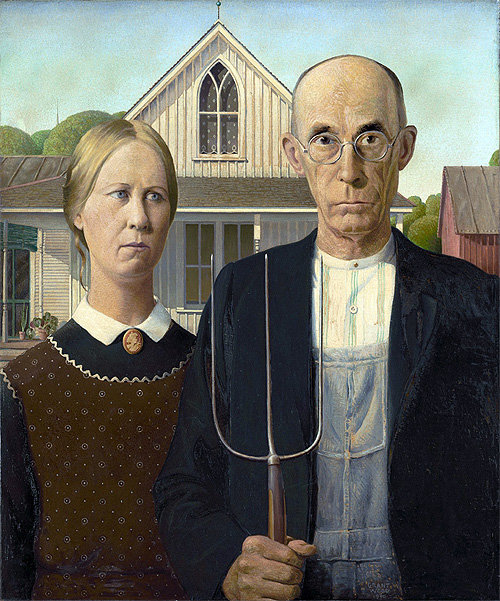The painting that won over critics
The painting that won over critics
Posted February. 13, 2020 07:50,
Updated February. 13, 2020 07:50

A man and a woman, who appear as farmers, are standing in front of a white house. The man, who is holding a pitchfork, is glaring at the audience with an unpleasant expression. The woman in an apron is glancing sideways looking uneasy. Though we don’t know why they are standing with such a strange expression, the painting “American Gothic” delivered fame to Grant Wood, who was an unknown artist from Iowa at that time.
The models depicted in the painting are the sister and dentist of the artist. They were 30 and 62 years at that time. The artist may have intended to depict a father and a daughter, but the painting was understood as a portrait of a couple. The white house in the background actually exists in Iowa, a typical American farmhouse emulating European Gothic style. Wood submitted the painting in the annual exhibition held at the Chicago Art Museum. When the painting was unveiled to the public, some viewers and critics praised the work, but most prominent critics heavily criticized the painting.
H.W. Janson (1913-1982), the author of “A Basic History of Western Art,” likened the painting to the artworks praised by Hitler, warning that artists and critics should stay wary of the opinion of the public. Clement Greenberg, also a famous art critic, explicitly downplayed the painting, saying that “failed painting of leading abstract painters” would be more interesting than “Wood’s most successful painting.” Since cubism and surrealism dominated the 1930s, followed by abstract expressionism, this painting might have been seen as an out-of-date artwork by a rural artist.
The public, however, went wild with the two figures in the painting. A painting of a diligent farmer who has overcome Iowa’s tough nature, representing the American who has achieved humble success on his own. A stubborn and conservative person living in the countryside. A couple who is struggling to hide negative emotions. People living in showy houses. People came up with various interpretations of the painting and rendered several parodies as well. The rural artist’s painting became an American icon. Eventually the best critics and experts could not win over public support.
Headline News
- N. Korea launches cyberattacks on S. Korea's defense companies
- Major university hospital professors consider a day off each week
- Italy suffers from fiscal deficits from ‘Super Bonus’ scheme
- Inter Milan secures 20th Serie A title, surpassing AC Milan
- Ruling and opposition prioritize spending amid tax revenue shortfalls







